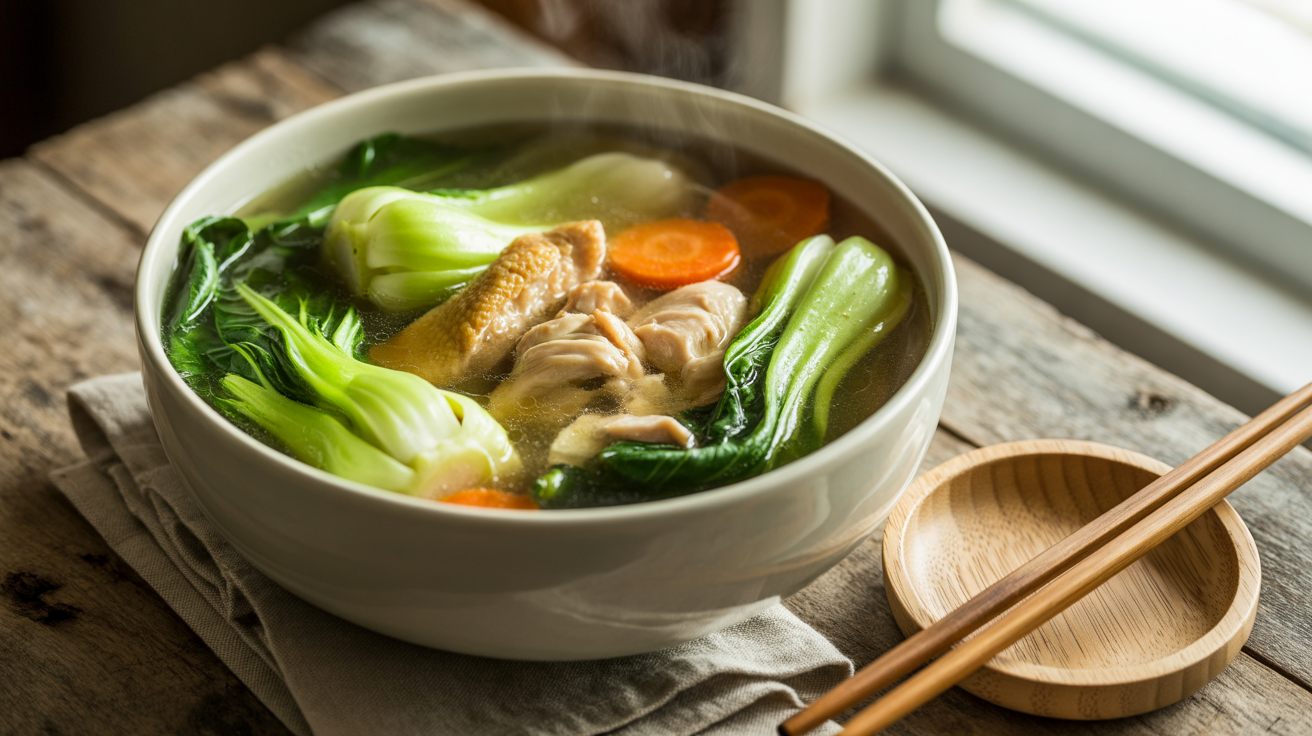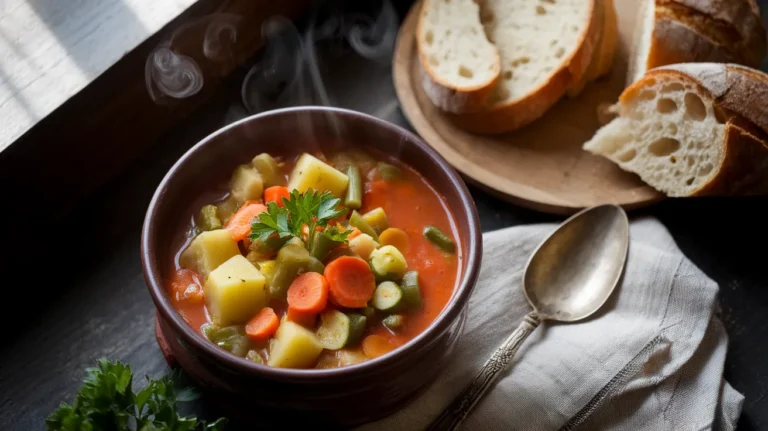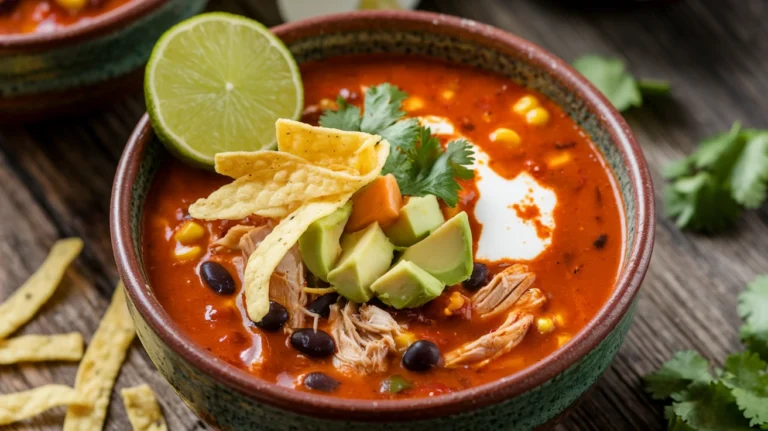This nourishing bokchoy chicken soup brings together tender chicken pieces and crisp bok choy in a soul-warming broth that’s perfect for any season. Our step-by-step bokchoy chicken soup recipe guides beginners through every detail, ensuring you create restaurant-quality results in your own kitchen with simple ingredients and foolproof techniques.
SERVES: 4 | PREP: 20 MIN | COOK: 25 MIN | TOTAL: 45 MIN
Ingredients for Perfect Bokchoy Chicken Soup
Protein & Broth Base
| Ingredient | Amount | Notes |
|---|---|---|
| Boneless chicken thighs | 1 lb | Cut into 1-inch pieces |
| Low-sodium chicken broth | 6 cups | Quality matters for flavor |
| Filtered water | 2 cups | To thin the broth |
Fresh Vegetables
| Ingredient | Amount | Preparation |
|---|---|---|
| Baby bok choy | 4 heads | Stems and leaves separated |
| Fresh ginger root | 2 inches | Peeled and minced |
| Garlic cloves | 4 large | Minced finely |
| Green onions | 4 stalks | White and green parts sliced |
| Medium carrots | 2 | Cut into thin rounds |
Seasonings & Flavor Enhancers
| Ingredient | Amount | Purpose |
|---|---|---|
| Low-sodium soy sauce | 3 tablespoons | Main seasoning |
| Pure sesame oil | 1 tablespoon | Aromatic base |
| Rice vinegar | 1 teaspoon | Brightness |
| Fine sea salt | To taste | Final seasoning |
| Ground white pepper | 1/4 teaspoon | Gentle heat |
Detailed Step-by-Step Instructions for Bokchoy Chicken Soup
Phase 1: Preparation and Setup (8-10 minutes)
Step 1: Prepare Your Workspace Set up your cooking station with all ingredients within arm’s reach. Place a large cutting board near your stove, and have a small bowl ready for scraps. This organization prevents rushing and ensures your bokchoy chicken soup turns out perfectly.
Step 2: Clean and Prep the Bok Choy Rinse each bok choy head under cold running water, gently separating the leaves to remove any dirt trapped between them. Pat completely dry with paper towels. Using a sharp knife, cut off the bottom 1/2 inch of the stem end. Separate the white stems from the green leaves – the stems take longer to cook and will be added first to your bokchoy chicken soup.
Step 3: Cut Bok Choy into Uniform Pieces Slice the white stems diagonally into 1/2-inch pieces – this diagonal cut increases surface area for faster, more even cooking. Cut the green leaves into 2-inch ribbons. Keep stems and leaves in separate bowls since they’ll be added at different times.
Step 4: Prepare the Chicken Remove any visible fat or skin from the chicken thighs. Cut into uniform 1-inch cubes – consistent sizing ensures even cooking throughout your bokchoy chicken soup. Pat the chicken pieces completely dry with paper towels to prevent oil splattering when cooking.
Step 5: Prep All Aromatics Peel the ginger using the edge of a spoon (this removes just the skin without wasting the flesh). Mince the ginger finely – you should have about 2 tablespoons. Peel and mince the garlic cloves. Slice the green onions, keeping white and light green parts separate from the dark green tops.
Phase 2: Building the Flavor Base (5-7 minutes)
Step 6: Heat Your Cooking Oil Place a heavy-bottomed soup pot or Dutch oven over medium heat. Add the sesame oil and let it heat for 1 minute until it shimmers slightly but doesn’t smoke. The oil is ready when a small piece of ginger sizzles immediately when added.
Step 7: Sauté the Aromatics Add the minced ginger and garlic to the hot oil. Stir constantly with a wooden spoon for 30-45 seconds until fragrant and just beginning to turn golden. Don’t let them brown completely or they’ll become bitter and overpower your bokchoy chicken soup.
Step 8: Add and Sear the Chicken Increase heat to medium-high. Add the chicken pieces in a single layer, being careful not to overcrowd the pot. Let them cook undisturbed for 2-3 minutes until the bottom sides develop a light golden color. This searing step adds depth of flavor to the final soup.
Step 9: Stir and Continue Cooking Gently stir the chicken pieces and continue cooking for another 2-3 minutes until most surfaces have some color. The chicken doesn’t need to be fully cooked at this stage – it will finish cooking in the broth.
Phase 3: Creating the Bokchoy Chicken Soup Broth (8-10 minutes)
Step 10: Add the Liquid Slowly pour in the chicken broth and water, scraping the bottom of the pot with your wooden spoon to release any browned bits. These flavorful bits will dissolve into the broth and enhance your bokchoy chicken soup significantly.
Step 11: Bring to the Right Temperature Increase heat to high and bring the mixture to a rolling boil – you’ll see large bubbles breaking the surface. Once boiling, immediately reduce heat to medium-low to maintain a gentle simmer. You should see small bubbles occasionally breaking the surface, not a vigorous boil.
Step 12: Add Carrots and Initial Seasoning Add the sliced carrots to the simmering broth. Add 2 tablespoons of soy sauce and the white pepper. Stir gently and let simmer for 5 minutes. The carrots should be slightly tender but still have some firmness when pierced with a fork.
Step 13: Test and Adjust Seasoning Using a clean spoon, carefully taste the broth (it will be hot!). Add more soy sauce if needed – remember, you can always add more but can’t take it back. The broth should taste well-seasoned but not overpowering.
Phase 4: Adding Vegetables and Final Cooking (5-7 minutes)
Step 14: Add Bok Choy Stems Add only the white bok choy stems to the simmering soup. These need 3-4 minutes to become tender. Stir gently to distribute evenly throughout the bokchoy chicken soup.
Step 15: Check Chicken Doneness After the stems have cooked for 3 minutes, cut into one of the larger chicken pieces to ensure it’s completely cooked through with no pink remaining. The internal temperature should reach 165°F if you have a thermometer.
Step 16: Add Bok Choy Leaves Add the green bok choy leaves to the pot. These delicate leaves need only 1-2 minutes to wilt and become tender. Stir very gently to avoid breaking them apart.
Step 17: Final Seasoning and Finishing Remove the pot from heat. Stir in the rice vinegar and the remaining 1 tablespoon of soy sauce. Taste one final time and add salt if needed. The vinegar brightens all the flavors in your bokchoy chicken soup.
Phase 5: Serving Your Bokchoy Chicken Soup (2-3 minutes)
Step 18: Prepare for Serving Have your serving bowls ready and warmed if possible (run them under hot water and dry). This keeps your bokchoy chicken soup hot longer.
Step 19: Ladle and Garnish Using a large ladle, divide the soup evenly among four bowls, making sure each gets a good portion of chicken, vegetables, and broth. Sprinkle the reserved green onion tops over each serving.
Step 20: Final Touch and Serve Drizzle a few drops of sesame oil over each bowl if desired. Serve immediately while the bok choy is still bright green and the soup is steaming hot.
Professional Chef’s Notes for Bokchoy Chicken Soup
Chicken Selection: Boneless thighs are essential for tender results in bokchoy chicken soup. Breast meat becomes dry and stringy during the simmering process, while thighs stay juicy and flavorful.
Bok Choy Quality: Choose baby bok choy with firm white stems and vibrant green leaves. Avoid any with yellow spots or wilted leaves, as these will turn bitter when cooked and ruin your bokchoy chicken soup.
Timing is Everything: The secret to perfect bokchoy chicken soup lies in adding ingredients at the right moments. Stems need more cooking time than leaves, so always separate and add them accordingly.
Broth Enhancement: For restaurant-quality depth, use a combination of chicken broth and bone broth. The gelatin from bone broth adds body and richness that elevates your bokchoy chicken soup significantly.
Nutrition Information (Per Serving)
- Calories: 285
- Protein: 28g
- Carbohydrates: 8g
- Fat: 15g
- Fiber: 3g
- Sodium: 1,240mg
- Vitamin A: 45% DV
- Vitamin C: 35% DV
Creative Bokchoy Chicken Soup Variations
Asian Fusion Bokchoy Chicken Soup: Add 2 tablespoons of white miso paste and sliced shiitake mushrooms for incredible umami depth. This creates a richer, more complex flavor profile similar to techniques used in our Tuscan chicken soup.
Spicy Korean-Style Version: Include 1-2 tablespoons of kimchi and a teaspoon of Korean chili flakes (gochugaru) for a fermented, spicy twist on traditional bokchoy chicken soup.
Protein-Packed Option: Add cubed firm tofu and sliced hard-boiled eggs in the final 2 minutes of cooking for extra protein without overwhelming the delicate flavors.
Hearty Noodle Bokchoy Chicken Soup: Stir in cooked rice noodles or ramen noodles during the last minute of cooking to create a more substantial meal, similar to our approach with chicken corn soup.
Storage & Reheating Your Bokchoy Chicken Soup
Refrigerator Storage: Cool completely before storing leftover bokchoy chicken soup in airtight containers for up to 4 days. The flavors actually improve overnight as they meld together.
Freezer Storage: This bokchoy chicken soup freezes beautifully for up to 3 months. Freeze in individual portions for quick weeknight dinners. Note that bok choy texture will soften slightly after freezing.
Proper Reheating: Thaw overnight in the refrigerator if frozen. Reheat gently over medium-low heat, stirring occasionally. Add a splash of fresh broth if the soup has thickened during storage.
Make-Ahead Tips: You can prepare all ingredients up to 1 day ahead and store them separately. The actual cooking process for bokchoy chicken soup is quick enough for fresh preparation.

Troubleshooting Common Bokchoy Chicken Soup Problems
Problem: Chicken pieces are tough and chewy
Solution: This usually means you used chicken breast instead of thighs, or you boiled the soup too vigorously. Always use thighs and maintain a gentle simmer. If this happens, shred the chicken and return it to the pot.
Problem: Bok choy leaves are mushy and brown
Solution: The leaves were overcooked. Green vegetables should be added in the final 1-2 minutes only. Next time, watch carefully and remove from heat as soon as the leaves wilt and turn bright green.
Problem: The bokchoy chicken soup tastes bland
Solution: You likely under-seasoned or didn’t build enough flavor base. Always taste and adjust seasonings gradually. Add soy sauce first, then vinegar for brightness, and finish with salt and pepper.
Problem: Soup is too salty
Solution: Add a peeled, halved potato and simmer for 10 minutes to absorb excess salt, then remove. Alternatively, add more unsalted broth and vegetables to dilute the saltiness.
Problem: Vegetables are unevenly cooked
Solution: Cut all vegetables uniformly and add them based on cooking time requirements. Carrots and bok choy stems need more time than delicate leaves.
Essential Equipment for Making Bokchoy Chicken Soup
Must-Have Tools:
- 6-quart heavy-bottomed soup pot – ensures even heat distribution
- Sharp chef’s knife – for efficient, safe prep work
- Large cutting board – preferably with a groove to catch juices
- Wooden spoon – won’t scratch your pot and won’t conduct heat
- Large ladle – for serving without spills
Helpful Extras:
- Fine-mesh strainer – for ultra-clear broth if desired
- Instant-read thermometer – to check chicken doneness
- Small prep bowls – to organize ingredients before cooking
Complete Shopping List for Bokchoy Chicken Soup
Meat Department
- 1 lb boneless, skinless chicken thighs
Fresh Produce Section
- 4 heads baby bok choy
- 1 piece fresh ginger root (2-inch piece)
- 1 head fresh garlic
- 1 bunch green onions (scallions)
- 2 medium carrots
Pantry & Condiment Aisles
- 6 cups low-sodium chicken broth
- Low-sodium soy sauce
- Pure sesame oil
- Rice vinegar
- Fine sea salt
- Ground white pepper
Expert Success Secrets for Perfect Bokchoy Chicken Soup
1. Mise en Place is Critical: Prepare and measure all ingredients before you begin cooking. Bokchoy chicken soup moves quickly once you start, and having everything ready prevents overcooking or burning.
2. Control Your Heat Carefully: The difference between tender and tough chicken lies in temperature control. Always maintain a gentle simmer after the initial boil – aggressive bubbling will toughen the meat.
3. Taste and Adjust Constantly: Great bokchoy chicken soup is built layer by layer. Taste after adding each seasoning component and adjust accordingly. Your palate is the best guide.
4. Timing with Vegetables: Add vegetables based on their cooking requirements, not convenience. This ensures every component reaches perfect doneness simultaneously in your bokchoy chicken soup.
5. Serve Immediately: This soup is at its absolute best when served fresh and hot. The bright green bok choy and steaming broth create both visual appeal and optimal flavor.
6. Save Some Garnish: Always reserve some sliced green onions for final garnish. Fresh elements added at serving time make each bowl of bokchoy chicken soup look restaurant-quality.
This comprehensive bokchoy chicken soup recipe transforms simple ingredients into an extraordinary comfort meal that’s both nourishing and satisfying. With these detailed instructions, even complete beginners can create professional-quality results every single time.




